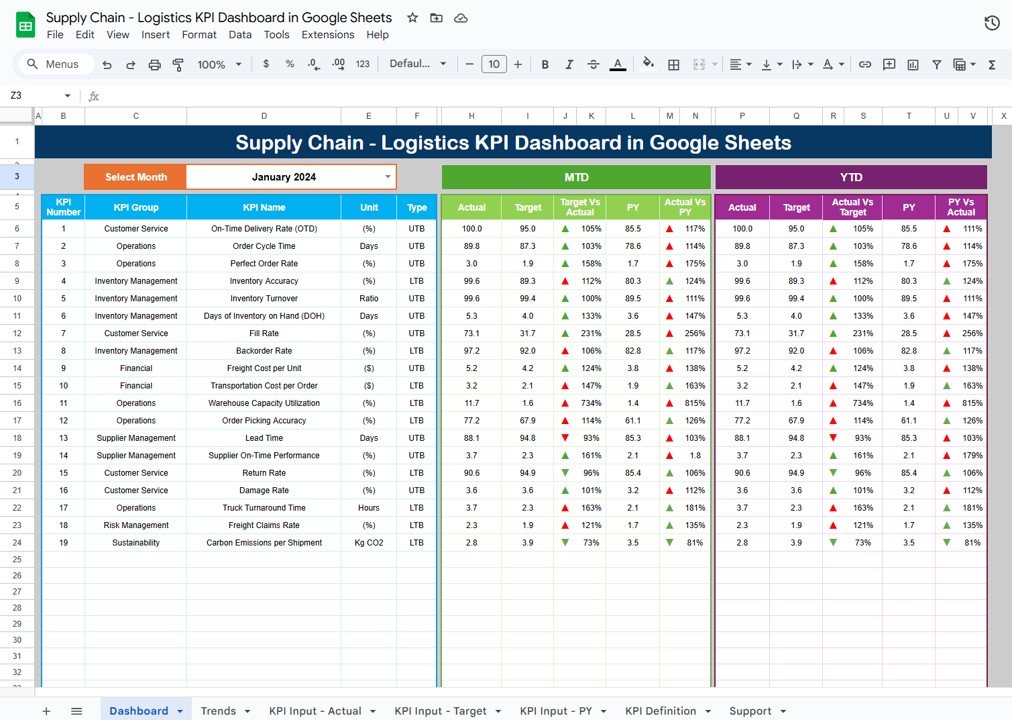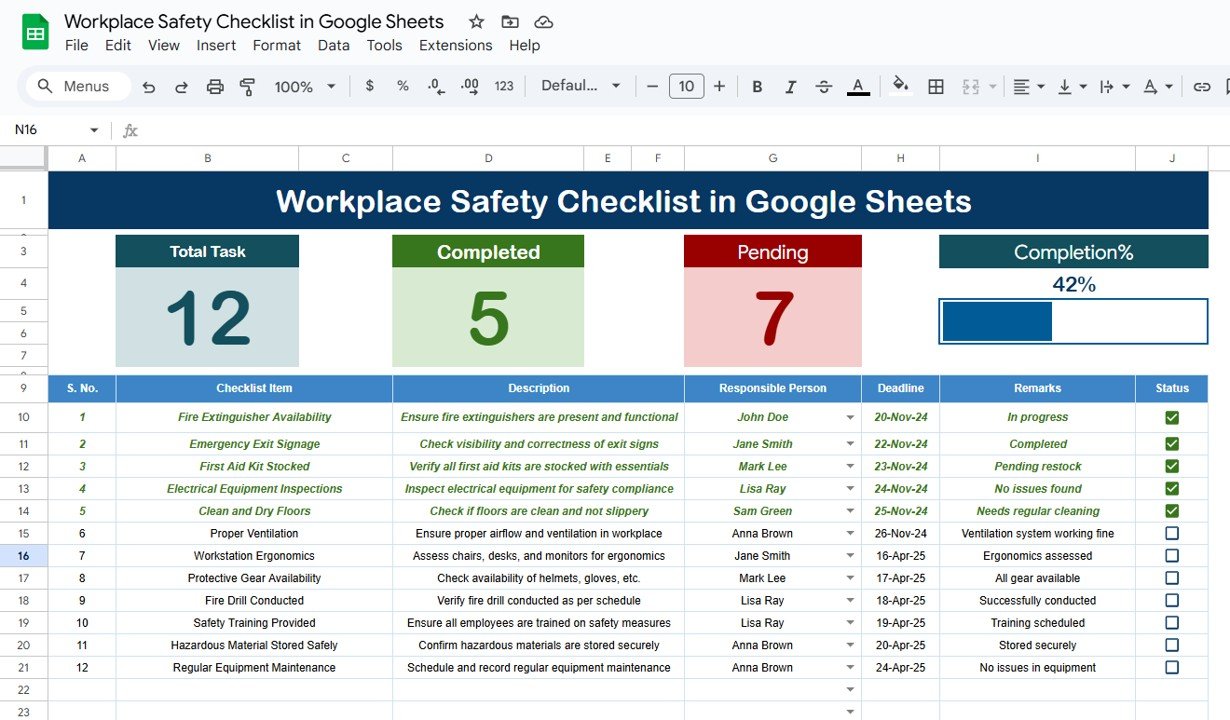In the investment management industry, it is essential to keep track of key performance indicators (KPIs) to evaluate investment performance, risk, and portfolio growth. A well-structured KPI dashboard helps investors and fund managers monitor their key metrics, make informed decisions, and maximize returns.
In this article, we will explore the Investment Management KPI Dashboard in Google Sheets—a ready-to-use template designed to help investment managers track essential KPIs efficiently. This guide will cover the KPIs, their definitions, formulas, and whether they should be “lower the better” or “upper the better.”
Key Features of the Investment Management KPI Dashboard in Google Sheets
Before diving into the specifics of the KPIs, let’s first understand the key features of this dashboard template:
Dashboard Sheet Tab
-
This is the main sheet where all KPI information is displayed.
-
Month Selection: On Range D3, you can select the month from the drop-down menu, and the entire dashboard will update accordingly.
-
MTD (Month-to-Date): Displays actual values, targets, and comparisons to previous year data with conditional formatting (up or down arrows).
-
YTD (Year-to-Date): Shows cumulative performance with comparisons to targets and previous year data.

Click to buy Investment Management KPI Dashboard in Google Sheets
KPI Trend Sheet Tab
-
Allows you to select KPIs from the dropdown in Range C3.
-
Displays KPI group, unit of measure, type (Lower the Better or Upper the Better), formula, and definition.

Actual Number Sheet Tab
-
Input actual numbers for both YTD and MTD for the selected month.
-
Change the month from Range E1 by entering the first month of the year.

Click to buy Investment Management KPI Dashboard in Google Sheets
Target Sheet Tab
-
Enter target values for each KPI for MTD and YTD.
-
Helps track performance against set goals.
Previous Year Number Sheet Tab
-
Enter data for the previous year in the same format as the current year for accurate year-over-year comparison.

KPI Definition Sheet Tab
Click to buy Investment Management KPI Dashboard in Google Sheets
-
Provides detailed information for each KPI, including:
- KPI Name
- KPI Group
- Unit of Measure
- Formula used to calculate the KPI
- Definition explaining the KPI

Click to buy Investment Management KPI Dashboard in Google Sheets
Advantages of Using the Investment Management KPI Dashboard in Google Sheets
An Investment Management KPI Dashboard in Google Sheets offers several advantages to investors and fund managers. Here are the key benefits:
-
Real-Time Monitoring: Track KPIs in real-time, enabling timely adjustments to investment strategies.
-
Customizable Templates: Google Sheets allows flexibility to modify KPIs, formulas, and layout based on specific investment goals.
-
Cost-Effective: Google Sheets is free to use, making it a budget-friendly option for investment firms.
-
Cloud-Based Collaboration: Teams can collaborate in real-time, ensuring everyone is aligned with the latest data.
-
Accessibility: Google Sheets can be accessed from any device with an internet connection, making it easy to monitor investments on the go.
Opportunities for Improvement in the Investment Management KPI Dashboard
While the Investment Management KPI Dashboard in Google Sheets is already a powerful tool, there are opportunities for improvement:
Automating Data Entry:
- Current Challenge: Manual data entry can be time-consuming and error-prone.
- Opportunity: Integrate the dashboard with external systems (e.g., portfolio management software) to automate data entry and reduce human error.
Advanced Visualizations:
- Current Challenge: Basic charts may not provide enough insight for complex portfolios.
- Opportunity: Add more advanced visualizations like heatmaps, line charts, and pie charts to enhance data interpretation.
Customizable Reporting:
- Current Challenge: Limited reporting options.
- Opportunity: Add options for generating customizable reports, such as PDF exports, or automated email summaries for stakeholders.
Best Practices for Using the Investment Management KPI Dashboard
Click to buy Investment Management KPI Dashboard in Google Sheets
To get the most out of the Investment Management KPI Dashboard in Google Sheets, consider these best practices:
-
Update Data Regularly: Keep the data updated frequently to ensure accurate insights into portfolio performance.
-
Set Realistic Targets: Use historical data and industry benchmarks to set achievable targets for each KPI.
-
Encourage Collaboration: Share the dashboard with key stakeholders to ensure that investment decisions are aligned across teams.
-
Monitor Key KPIs: Focus on essential KPIs like portfolio return, risk-adjusted return, and alpha to assess investment success.
-
Leverage Conditional Formatting: Use color-coded arrows or thresholds to make trends and performance deviations instantly visible.
Conclusion
The Investment Management KPI Dashboard in Google Sheets is a valuable tool for investment professionals to track key performance metrics and make informed decisions. By using this dashboard, managers can monitor portfolio performance, assess risk, and ensure that investment goals are being met efficiently.
Frequently Asked Questions (FAQs)
What is a KPI in investment management? A KPI (Key Performance Indicator) is a measurable value that indicates how effectively an investment portfolio is performing. Common KPIs include portfolio return, risk-adjusted return, and alpha.
How do I customize my Investment Management KPI Dashboard? You can customize the dashboard by adding or removing KPIs, adjusting formulas, and modifying the layout to fit your specific investment strategy.
How do I enter data into the Investment Management KPI Dashboard? Simply input actual data for MTD and YTD in the relevant sheets (Actual Numbers Sheet, Target Sheet, Previous Year Numbers Sheet) for each month.
Can I automate the data entry process? Yes, by integrating with external systems like portfolio management software, you can automate data entry and reduce manual input errors.
Which KPIs should I track for my investment portfolio? Key KPIs for investment management include portfolio return, risk-adjusted return, alpha, beta, and expense ratio.
Visit our YouTube channel to learn step-by-step video tutorials
Youtube.com/@NeotechNavigators
Watch the step-by-step video Demo:
Click to buy Investment Management KPI Dashboard in Google Sheets



